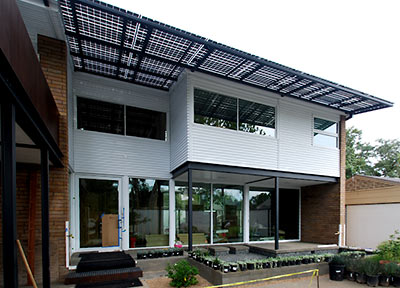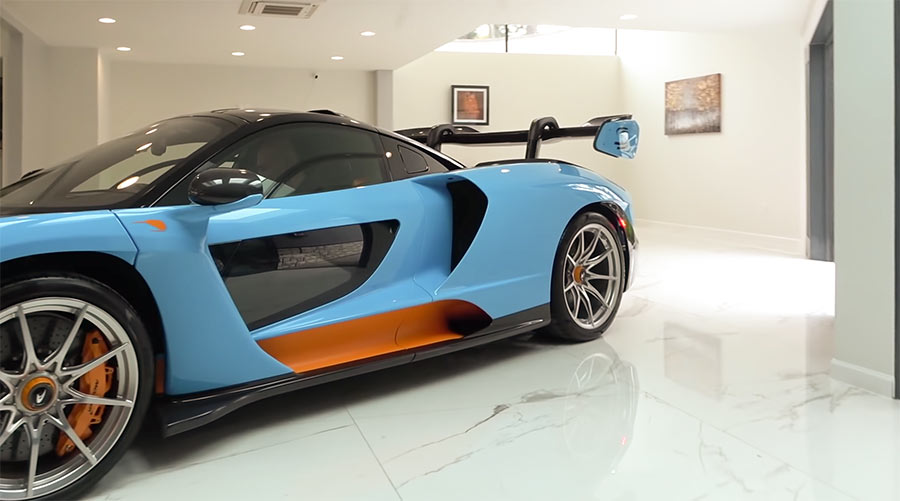
For the home she’s building for her family on Banks St., on the former site of a carefully disassembled Ranch house in Ranch Estates, architect Karen Lantz tried to make sure every product was made in the United States. But the breaking point came with cabinet hardware, Mimi Swartz writes: “‘This one?’ Lantz said, picking up the pull on the left and turning it over for my inspection. ‘From Italy. Nine dollars.’ She picked up the one on her right. ‘This one?’ She paused. ‘China. Four dollars.’ The U.S.-made pull that was closest to what she wanted cost $72. She called company after company trying to do better. When she asked why the American pulls cost so much more than those made overseas, the answers ranged from ‘We make them here’ to ‘It’s a classic.'”
***
Time passed; the cabinet installers grew restless. Finally, Lantz gave in and bought Italian. (She has tried to avoid Chinese products since problems with contaminated drywall surfaced in the early 2000s.)
“I needed 160 of them,” she explained. “It was a big price difference, and I just couldn’t do it. I tried, but I just couldn’t do it.”
Near completion on the house, Lantz estimates she came within 90 percent of her goal. In addition to the pulls, she gave in to sinks from Germany and faucets from Italy, and when Lantz fell in love with solar panels designed in Colorado but manufactured in China, she threw in the towel.
- The (Almost) All-American Home [NY Times]
- Previously on Swamplot: The Slowest Demo in Town: Karen Lantz Pulls a House Apart
Photo: Karen Lantz





At least she tried. Anyone know where I can find a pair of sneakers at least made in this hemisphere?
New Balance is the last frontier of US tennis shoe manufacturing, but only a small percentage of their line. The old-style 993’s I am wearing are made in USA.
“At least she tried. Anyone know where I can find a pair of sneakers at least made in this hemisphere?”
New Balance. Made in the US of A.
She should have had them custom fabbed by someone in the US. Its’a good end to her story and free publicity for the whoever makes them.
Go with the Italian cabinet hardware.Not because it’s Italian,per se, because it’s NOT Chinese-no matter how much less Chinese products are-they’re just cheaply made junk; and because,in this case,the American cabinet hardware was many times way more expensive than the imported Chinese & Italian products.Chinese: 160 pieces@ $4 each = $640.Italian: 160 pieces@ $9each = $1440. AMERICAN :160 pieces@ $72 x= $11520 !!!
I would have recycled some of the materials from the old house into the new one. Save $$$,the environment and go a bit greener at the same time!!! Just saying.
Meh, I’m not for or against apathy on this one.
There are a lot of unquestioned assumptions about trade here.
Do you have to get the USA NB online, because those I’ve seen is stores are all made in Chine. Their spelling, not mine.
PS, Looking at you Academy.
Two words: plaintiff attorneys.
It sounds like the price for the American made drawer pull is expensive, but I would bet it is a pull that the company makes very few of and it is most likely hand finished or even hand forged at that price…….. The one from China is most likely a pull made from an alloy plated with whatever finish it is trying to look like, such as copper or aged bronze…. The cheaper is also never going to have the crisp detail you will see if the pulls are hand finished or forged by hand. I love a bargain, but cheap knockoffs are never a bargain since you end up replacing them like toilet paper. Homes from the 1800’s managed to feature solid wood interior doors, wood details throughout the home, wood floors, handmade wooden windows which today would cost you a pretty penny from Jeldwen or Pella….. Technology is supposed to make our life easier and the cost of making various products cheaper, so where is the savings? We as consumers should expect the best at a fair price instead of settling for the overpriced lack luster things we see today…. Also inflation isn’t to blame for the rising cost of quality consumer goods, the idea a dollar is some how worth more now than it was a hundred years ago is an idea that does not hold water…..what has driven the cost of living to the breaking point is plain greed……companies need to stop trying to post bigger profit numbers and instead focus on keeping earnings steady…..also the million dollar home boom is CRAY-CRAY since Houston has the Eastside neighborhoods waiting for buyers to wake up and realize the freeway doesn’t make your home in Southhampton more special, many of those homes sat closed up for years….It’s time to stop labeling one area better than another so we can get to work fixing the problems…..
For the price of 160 american made pulls one could buy their own CNC machine and just make the pulls themselves (obviously it isn’t that simple, but still). I would have just contracted the work out to a local metal fabrication shop or artist, I’m sure you could have got the price down to less than 20 a piece.
Charles is going crazy up there ;-)
Automation is the key to using the technology that makes life easier. we’re getting to a point where we can automate all of this stuff, robots and controller programs are getting more sophisticated in what they can accomplish.
it’s very likely that the USA door pulls are for the most part, hand made, but then, the ones in China and Italy are probably handmade to an extent as well. problem is, they can get away with paying their workers a fare wage in their economy which is very cheap. Over here the skilled laborer that makes those door pulls gets paid $20 an hour, over there it’s $20 a week.
as to the east end being a wonderful place to live at 1/4 the price of other in the loop options, yes, it is. but I like it the way it is, so anyone who wants to come over, please leave the historic districts and walmart hate in the heights.
Patrick – click the link that’s embedded in the article. The pulls were probably reused by somebody else.
Maybe the architect could revise her preferences and find some different, more affordable handles that are made in the U.S.
Aesthetics vs what’s practical is a tough compromise, isn’t it?